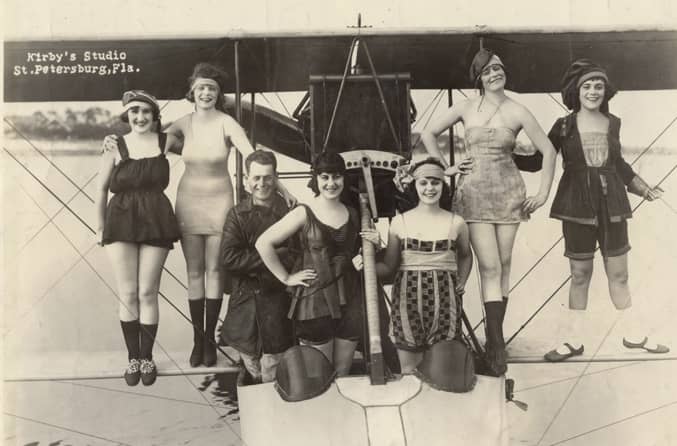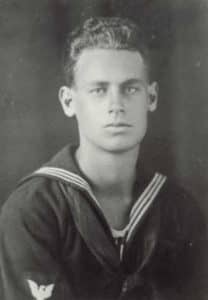Create
Vintage St. Pete: The legend of Albert Whitted


Airman Whitted, Navy pilot #179. Wiki Commons.
The namesake of St. Petersburg’s historic bayfront airfield was also the city’s first hometown hero.
Born in St. Pete in 1893, James Albert Whitted was the son of Thomas Albert “T.A.” Whitted, who’d relocated from Boone, Iowa, by mule train. He married Julia Jeanettie Phillips; her father Zephaniah, a Civil War veteran, was one of the first wave of Long Key homesteaders. Zephaniah Phillips built the first home on Pass-a-Grille and held several patents for mechanical inventions.
T.A. and Julia built a house of their own in Gulfport; James Albert – everyone called him “Al” – was the third son of nine children (four of his siblings died at a very young age). T.A. built the area’s first sawmill, built and installed doors and windows, and played double bass in St. Pete’s first orchestra.
A gifted mechanic, like his father and grandfather, Albert Whitted (a graduate of St. Petersburg High School) opened a motorcycle repair and sales shop on Central Avenue. While cycle racing in New Haven, Connecticut, he took an interest in aviation, and subsequently learned not only to fly, but to maintain and repair aircraft.

Lt. Whitted. Wiki Commons.
At the outset of World War I, he enlisted in the US Army aviation corps, and was sent to the naval base in Pensacola, where he taught seaplane aviation. In 1918, he was commissioned as a first lieutenant and made chief instructor in advanced flying. He married Frances Louise Brent, of Pensacola, and until his tragic death five years later, the couple and their two daughters divided their time between homes in that Panhandle town and St. Petersburg.
From the airplane hangar at the Vinoy Basin – where Tony Jannus had launched his over-water passenger service back in 1914 – Whitted began a sight-seeing company, taking passengers over Tampa Bay and the beaches in his seaplane Bluebird. Early accounts say he did it for free, but eventually started charging $10 per “long” flight.
 In 1921, Whitted built an experimental seaplane that was lighter and faster than its predecessor. Falcon, as it was named, had an unusual four-bladed propeller and could reach speeds of 100 mph.
In 1921, Whitted built an experimental seaplane that was lighter and faster than its predecessor. Falcon, as it was named, had an unusual four-bladed propeller and could reach speeds of 100 mph.
A member of the St. Petersburg Civitan Club, Whitted was lauded for successful rescue missions off the coast, and for his “selfless” dedication to public service. His seaplanes, said his longtime friend Bob Smalley, were “always at the call of anyone” who had a civic purpose.
Lieut. Albert Whitted, local aviator, inaugurated his commercial tours here Saturday in flights to Fort Myers and Tampa. Accompanying him to Fort Myers were E.H. Tomlinson, Art Foster and T.R. Fleet. After returning from Tampa (sic), Lieut. Whitted carried Bob Smalley, Rollin Wilkinson and A.F. Bairnsfather to Tampa, where it was made possible for Smalley to deliver a new automobile to Bairnsfather, just 20 minutes after the car had been ordered in St. Petersburg. Bairnsfather is an artist from New York who is spending the winter here.
St. Petersburg Times/Jan. 21, 1923
Despite the fact that they are planning a seven-day tarpon fishing trip that will take them 50 miles down the gulf cost by Tuesday, Chal. Laughner, Fred Ausiobrook and Joe Kerrick plan to come back to St. Petersburg on that day to vote on the county road bonds and mayor’s recall. The trio have arranged with Al Whitted to pick them up wherever they are Tuesday morning in his seaplane Falcon, and whisk them back to the Sunshine city, and then take them again to their tarpon grounds.
St. Petersburg Times/June 2, 1923
What is believed to have been the first non-stop flight between St. Petersburg and Pensacola in a commercial seaplane was made Sunday by Lieut. Albert Whitted who left here Sunday morning at 4:45 a.m. reaching Pensacola four and a half hours later. On previous flights to Pensacola Whitted stopped off at Cedar Keys for fuel and gas, but Sunday he put enough fuel on board to take him through the entire trip. He will return here about Christmas to resume his commercial flying business.
St. Petersburg Times/July 3, 1923

Whitted (left) with passenger on Bluebird, circa 1919. Photo: St. Petersburg Museum of History.
On Aug. 19, Whitted was flying Falcon over Santa Rosa Sound, off the coast of Pensacola, with four paying passengers aboard, when the propeller (mounted behind the wings and cockpit) loosened and flew into the rear fuselage, severing all control wires.
The plane plunged 200 feet into the Gulf of Mexico. All five people on board were killed instantly.
James Albert Whitted, just 30 years old, was buried at St. Michael’s cemetery in Pensacola.
St. Petersburg’s lone airfield at the time was Piper-Warren, where Tyrone Square Mall is now (there was also a private landing strip on Weedon Island).
On Oct. 12, 1928, city commission approved construction of an airfield on the southern bayfront. Known as the Cook-Springfield tracks, some reports suggest there was already a primitive airstrip at the site when (re) construction began. Council earmarked $750 to “clean up” Piper-Fuller by fixing runway potholes and mowing down weeds.

Postcard image, circa 1934
The new facility, named for Albert Whitted, opened in the summer of 1929. It boasted several runways, the longest of which was 2,500 feet.
Initially used for commercial flights (National Airlines flew in and out for a decade, starting in the mid ‘30s), it was utilized for Coast Guard and other military operations during World War II. Since the 1960s, Albert Whitted Airport has served private and charter air businesses. It remains a city-owned property.
“Albert was a mechanical genius,” his nephew Eric Whitted said in 1988. “I am convinced that if the Falcon had survived, it would be hanging in the Smithsonian today.”
This story appears in the book Vintage St. Pete & Vintage Pinellas Volume 3 (St. Petersburg Press).

Whitted (seated in cockpit) with passengers, the DuBois family, posing with Falcon in 1922. Whitted died aboard this seaplane Aug. 19, 1923. Photo: St. Petersburg Museum of History.








Mike Haraseviat
April 16, 2022at9:37 am
Great article Bill!